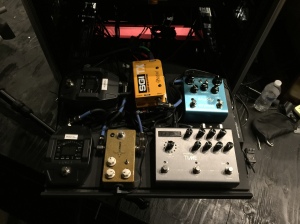Now for the fun stuff. Here’s what lies within my side rack:
From top to bottom:
- Furman Power Conditioner
- 1U Pull-out Rack Shelf
- M-Audio AIR 32 MIDI controller (Used for synth leads)
- Novation Launchpad Mini (Used to fire and manage loops/ sequences)
- Powered USB Hub
- Shure In Ear Monitor System (This allows me to have a wireless mix (No cable hassle… YAY!)
- Furman Power Conditioner
- Focusrite 18i20 interface (Sends out a variety of sounds like click, voice countoffs, synths, pads, pianos, etc.)
- (2) Radial Pro D8 Passive Rackmount DIs (Used to take signal from 18i20 and send it to the main house board
- 2U Rack Drawer (Used to store replacement sustain pedals and whatever else I may need to fix things on the fly)
Each power conditioner controls a specific set of tools to make sure no hum or buzz is generated. Anything connected to the first power conditioner is anything not musical equipment (Computer, USB hub fan, pedalboard power, power to separate pedals, wireless IEM, etc.
The second power conditioner powers things anything that is a musical instrument. So anything like my Prophet 08, or Moog Sub 37, audio interface, power for Radial SGI Boxes, and any other goodie I decide to run that weekend will be powered through this conditioner.
The reason why I mentioned a pedalboard and its need for power is because there is a back side to the rack:
This little pedalboard and its power is managed through the rack. It’s got two Shure guitar tuners that double as a wireless unit so there are no messy cables to deal with. The acoustic tuner goes out to a Radial J48 and the Electric Guitar setup goes to a Radial SGI Box that gets wired into a Morgan DAG 15. There’s also a JHS Morning Glory for some grit and a Strymon Bluesky for a shimmery reverb.
The Strymon Timeline is the special part of the board because it’s the one thing that is controlled by Ableton via the audio interface. To make things easier for our WL, we made it to where Ableton controls the delay as well as its programming. For example, for a fast song our WL would want a quick dotted eighth delay with a short trail, Ableton will switch to that setting once I trigger the song. When we go to a slower song, he may want a quarter note delay with a longer shimmery trail. Ableton makes these kinds of changes so he doesn’t have to think twice. The best part is Ableton will constantly make sure that the tempo doesn’t fluxate on the delay. The wonders of MIDI.




